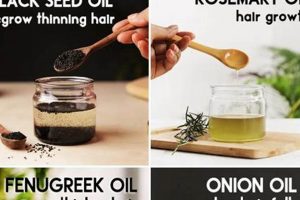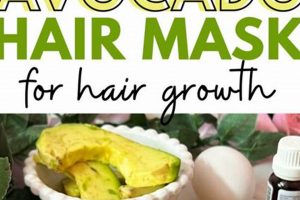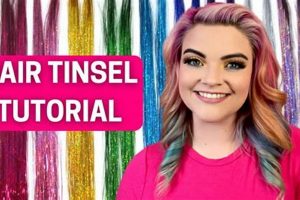Creating personalized adornments for the hair offers a unique avenue for self-expression and resourcefulness. This encompasses a range of handcrafted items, from embellished headbands and intricately designed barrettes to custom-beaded hair ties and fabric-covered clips. For example, an individual may transform a plain plastic headband into a statement piece by attaching beads, ribbons, or repurposed jewelry findings.
The practice of crafting these items provides several advantages. It allows for the creation of pieces that perfectly match individual style preferences and specific outfits, offering an alternative to mass-produced items. Moreover, it promotes sustainability by utilizing recycled materials and reducing consumer waste. Historically, decorating the hair has been a significant aspect of personal presentation across various cultures, and this practice enables individuals to connect with that history through a modern, creative lens. The process fosters creativity and provides a tangible outlet for artistic expression.
The following sections will delve into specific techniques for producing various types of these handcrafted items, outlining the necessary materials, providing step-by-step instructions, and exploring a range of design possibilities.
DIY Hair Accessories
Achieving professional-looking, durable, and aesthetically pleasing handcrafted hair adornments requires careful attention to detail and a strategic approach. The following tips offer guidance on key aspects of the creation process.
Tip 1: Material Selection: Opt for high-quality materials appropriate for the intended use. Consider the durability of fabrics, the strength of adhesives, and the longevity of embellishments. For instance, using marine-grade glue for adhering beads to a hair clip will ensure greater resistance to water damage and detachment than standard craft glue.
Tip 2: Secure Attachment Methods: Implement robust attachment techniques to prevent embellishments from detaching. This includes using multiple attachment points, employing strong knots for beaded designs, and reinforcing sewn elements. Example: When attaching a large flower to a headband, consider using both glue and stitching to ensure stability.
Tip 3: Design Planning: Before commencing construction, develop a detailed design plan. This includes sketching the intended design, determining the appropriate dimensions, and accounting for material availability. Planning can prevent errors and minimize material waste.
Tip 4: Proper Tool Usage: Utilize appropriate tools for each step of the process. Employ sharp scissors for clean fabric cuts, needle-nose pliers for manipulating small beads, and hot glue guns with temperature control for precise adhesive application. Using the correct tools improves efficiency and reduces the risk of damage to materials.
Tip 5: Edge Finishing: Pay attention to edge finishing to prevent fraying and improve the overall aesthetic. Techniques such as serging, binding, or applying fabric sealant to raw edges enhance durability and provide a polished appearance. For example, the edges of ribbon used in a hair tie can be heat-sealed with a lighter to prevent fraying.
Tip 6: Testing and Refinement: Before completing a large batch of designs, create a prototype to test the design’s durability and functionality. Subject the prototype to normal wear and tear to identify potential weaknesses and areas for improvement. Adjust the design accordingly.
Tip 7: Storage Considerations: Proper storage protects finished pieces from damage. Use individual compartments or padded containers to prevent scratches, tangles, and dust accumulation. Consider storing delicate pieces in airtight containers to prevent tarnishing or deterioration.
Applying these strategies results in handcrafted hair adornments that possess both visual appeal and functional longevity. Investing time in planning, material selection, and proper execution ensures a high-quality finished product.
The next section explores specific design ideas and patterns for various types of handmade hair decorations.
1. Material Selection
Material selection constitutes a foundational element in the creation of handcrafted hair decorations. The choices made regarding materials directly influence the durability, aesthetic, and overall quality of the finished product. Prudent material selection optimizes resource utilization and enhances the artistic value of these personalized adornments.
- Durability and Longevity
The chosen materials dictate the lifespan of the hair accessory. For instance, using stainless steel clips instead of cheaper alloys prevents rust and maintains functionality over time. Similarly, opting for high-quality, colorfast fabrics ensures that decorative elements retain their vibrancy despite exposure to sunlight or repeated washing. Material durability directly affects the accessory’s ability to withstand daily wear and tear.
- Aesthetic Impact
Material choices significantly contribute to the aesthetic appeal of the item. The selection of beads, ribbons, fabrics, and embellishments dictates the overall visual impression. For example, silk ribbons project a more luxurious image compared to synthetic alternatives, while glass beads offer greater brilliance than plastic versions. Careful consideration of texture, color, and sheen enhances the design’s visual impact.
- Cost Efficiency
Balancing cost with quality represents a crucial aspect of material selection. While premium materials may elevate the aesthetic and durability, their cost can impact the accessibility of this craft. Sourcing materials from wholesale suppliers, utilizing recycled materials, or substituting expensive components with cost-effective alternatives enables creators to manage expenses without compromising essential qualities. Strategic procurement ensures financial sustainability.
- Workability and Ease of Use
The properties of selected materials affect the ease with which they can be manipulated and assembled. Materials like pliable wire and soft fabrics are easier to work with than rigid metals or stiff textiles. The choice of user-friendly materials simplifies the construction process, reducing errors and improving the overall efficiency of creating customized hair decorations. This ease of use is important for both novice and experienced crafters.
The interplay between durability, aesthetics, cost, and workability in material selection directly influences the success of handcrafted hair decoration projects. Informed choices enable artisans to produce high-quality, visually appealing, and economically viable creations. Thorough consideration of these factors is vital for realizing the full potential of this personalized art form.
2. Design Conceptualization
Design conceptualization serves as the genesis for all handcrafted hair accessories. It establishes the framework within which materials are selected, techniques are employed, and the ultimate aesthetic form is realized. Absence of a well-defined conceptualization can lead to unfocused execution, resulting in pieces that lack cohesion and visual appeal. Consider the difference between a haphazard collection of beads attached to a clip, versus a carefully planned arrangement of complementary colors and textures, resulting in a cohesive and visually striking barrette. The conceptual phase determines the impact of the final creation.
Effective design conceptualization involves several key stages. Initially, inspiration may be drawn from diverse sources, including current fashion trends, historical styles, natural elements, or abstract concepts. This inspiration is then translated into a tangible design through sketches, mood boards, or digital renderings. Prototyping with inexpensive materials allows for the exploration of different forms and techniques without incurring significant costs. A thorough understanding of the materials’ properties and limitations is crucial during this stage. The deliberate arrangement of components, anticipating how they will interact and support the desired aesthetic, distinguishes a successful conceptualization.
Ultimately, effective design conceptualization is the critical determinant of success in creating handmade hair accessories. A clear, considered design improves the efficiency of the creation process, reduces material waste, and enhances the overall quality and appeal of the finished product. Understanding the pivotal role of this conceptual phase enables artisans to create unique, personalized pieces that reflect their individual style and vision, elevating these handcrafted items beyond mere functional objects.
3. Tool Proficiency
The creation of handcrafted hair accessories necessitates a demonstrable proficiency in the utilization of various tools. Effective tool handling directly influences the quality, precision, and durability of the finished product. Inadequate tool skills can result in flawed designs, compromised structural integrity, and increased material waste.
- Cutting Implements Mastery
Scissors, rotary cutters, and craft knives are essential for shaping fabrics, ribbons, and other decorative materials. Precise cuts are critical for achieving clean lines and preventing fraying. Proficiency involves understanding the properties of different cutting tools and selecting the appropriate implement for each material. An example includes utilizing sharp fabric scissors for delicate silks and a rotary cutter for efficiently trimming long stretches of ribbon. Improper use can lead to jagged edges and material wastage.
- Adhesive Application Expertise
Hot glue guns, fabric glues, and epoxy resins are frequently employed to secure embellishments and assemble components. Competent adhesive application requires knowledge of adhesive properties, appropriate dispensing techniques, and safety precautions. Applying too much adhesive can result in unsightly residue, while insufficient application can lead to detachment. Expertise in temperature control with hot glue guns minimizes the risk of burning materials and ensuring optimal bonding strength. An example is using a precision tip applicator for intricate beadwork.
- Needle and Thread Dexterity
Sewing skills, whether manual or machine-based, are crucial for attaching fabrics, securing embellishments, and reinforcing structural elements. Proficiency encompasses threading needles, tying secure knots, and executing various stitch types. Hand-sewing allows for detailed and precise work, while machine sewing offers speed and efficiency for larger projects. Incorrect stitching techniques can result in weakened seams and potential disintegration of the accessory. An example includes using a blind stitch to invisibly hem the edges of fabric-covered headbands.
- Pliers and Wire Management
Pliers, wire cutters, and wire bending tools are indispensable for creating wire-based designs, attaching beads, and manipulating findings. Proficiency entails understanding the different types of pliers, their intended applications, and the proper techniques for bending and shaping wire without causing damage. Inappropriate tool use can result in bent or broken wires, compromised structural integrity, and potential safety hazards. An example is using round-nose pliers to create consistent loops for attaching charms to a hair comb.
These facets of tool proficiency are intertwined and collectively contribute to the success of handmade hair accessory projects. Mastering these skills not only enhances the quality of the finished products but also fosters efficiency and reduces material waste. Enhanced competence in these areas elevates the craft from a simple hobby to a skilled art form, capable of producing professional-grade, personalized hair adornments.
4. Attachment Security
Attachment security represents a critical determinant of the longevity and usability of handcrafted hair accessories. Insufficiently secured embellishments or components undermine the functionality and aesthetic value of the item, rendering it impractical for sustained use. The relationship is causal: inadequate attachment directly leads to the detachment of components, diminishing the item’s lifespan. This facet is paramount within the context of these personalized adornments as their inherent value stems from their unique design and the integration of various elements. For instance, a meticulously beaded barrette loses its appeal and practical use if the beads detach within a short timeframe. A ribbon glued to a hair clip that falls off soon after creation highlights the critical need for robust attachment strategies. Without secure attachment, the accessory becomes a transient creation, failing to provide lasting value or practical utility.
Achieving adequate attachment security necessitates careful consideration of both the adhesive properties of bonding agents and the mechanical strength of joining techniques. Proper surface preparation, appropriate selection of adhesives for the materials being joined, and the implementation of reinforcing measures, such as stitching or wire wrapping, contribute to durable bonds. Practical application involves, for example, using industrial-strength adhesive and multiple anchoring points when attaching heavy embellishments like rhinestones to a headband. Additionally, stress-testing prototypes to identify potential weak points allows for design refinements and the incorporation of stronger attachment methods. For example, a childs hair bow needs to have all decorations so securely fastened that they cannot come loose with wear and tear, and must be tested by hand before wearing.
In summary, the secure attachment of components is fundamental to the creation of durable, aesthetically pleasing, and functional handcrafted hair accessories. Challenges in achieving robust attachment may arise from material compatibility issues, inadequate tool skills, or insufficient attention to detail during the construction process. Addressing these challenges through informed material selection, meticulous application techniques, and rigorous testing ensures that the final product meets both aesthetic expectations and practical requirements. A comprehensive understanding of attachment security is thus vital for any artisan engaged in the creation of these personalized adornments, ensuring customer satisfaction and product longevity.
5. Durability Enhancement
Durability enhancement in the context of handcrafted hair adornments refers to strategies and techniques implemented to prolong the lifespan and maintain the structural integrity of these items. Given that these accessories are often subject to daily wear and tear, environmental exposure, and physical stress, durability enhancement is a crucial consideration during the design and construction phases.
- Material Selection for Resilience
Choosing materials known for their strength and resistance to degradation directly impacts the longevity of the accessory. Stainless steel or high-carbon steel findings offer superior resistance to rust and corrosion compared to cheaper alloy alternatives. Similarly, selecting fabrics with tightly woven structures and colorfast dyes prevents premature fading and fraying. For example, a barrette constructed with a robust metal clip and embellishments securely attached with industrial-strength adhesive is inherently more durable than one made with weak glue and easily damaged components.
- Reinforcement of Weak Points
Identifying and reinforcing potential points of failure is essential for maximizing durability. This can involve reinforcing seams with multiple rows of stitching, adding protective coatings to delicate embellishments, or strategically placing structural supports within the design. For instance, reinforcing the attachment points of beads on a hair comb with wire wrapping strengthens the connection and prevents bead loss. Addressing weak points proactively minimizes the risk of damage during regular use.
- Protective Finishing Techniques
Applying protective finishes can shield the accessory from environmental factors and physical damage. Sealants, varnishes, and fabric protectors can enhance water resistance, prevent staining, and reduce wear and tear. A coating of sealant on a painted wooden hair clip protects the design from scratches and fading. Similarly, a fabric protector applied to a silk flower can prevent staining and water damage. Protective finishes extend the life and maintain the aesthetic appeal of the accessory.
- Robust Construction Methods
Employing strong and reliable construction methods contributes significantly to the overall durability. This includes using secure knots for beaded designs, implementing multiple attachment points for embellishments, and utilizing appropriate stitching techniques for fabric components. For example, using a double knot for securing beads on a hair tie provides greater resistance to breakage than a single knot. Similarly, using a reinforced stitch for attaching a ribbon to a headband enhances the bond’s strength. Utilizing robust construction methods ensures the structural integrity of the finished accessory.
The integration of these durability enhancement strategies is paramount to creating handcrafted hair adornments that withstand the rigors of daily use and maintain their aesthetic appeal over time. These measures enhance the perceived value of the handcrafted item and contribute to user satisfaction.
6. Aesthetic Refinement
Aesthetic refinement in the context of handcrafted hair accessories denotes the deliberate process of enhancing the visual appeal and artistic merit of these creations. It encompasses the application of design principles, material selection, and construction techniques aimed at achieving a high degree of visual harmony and artistic sophistication.
- Harmonious Color Palette Selection
The selection of a cohesive and visually pleasing color palette plays a pivotal role in aesthetic refinement. Careful consideration of color theory, including complementary, analogous, and triadic color schemes, enhances visual harmony. For example, a hair clip featuring a gradient of blues and greens evokes a sense of tranquility, while a combination of reds and golds exudes richness and opulence. The impact of a poorly chosen palette is discordance. This is a core element of a final touch.
- Balanced Proportionality and Scale
Achieving balanced proportionality and scale is essential for visual appeal. The size and placement of embellishments must be carefully considered to avoid overwhelming the overall design or creating a sense of imbalance. For instance, a large bow placed on a small barrette can appear disproportionate, while a scattering of tiny beads may appear insignificant on a large headband. The appropriate scaling of elements ensures visual equilibrium.
- Intentional Textural Contrast
The strategic juxtaposition of contrasting textures adds depth and visual interest. Combining smooth and rough textures, matte and shiny finishes, or soft and rigid materials creates a dynamic tactile experience. For example, a hair tie combining smooth silk ribbon with rough burlap creates visual contrast. Too much can be distracting, too little can be boring.
- Polished Finishing and Detailing
Attention to detail and a polished finish elevate the overall aesthetic quality. This includes ensuring clean lines, secure attachments, and the removal of any imperfections or extraneous elements. For instance, neatly trimming frayed edges of ribbons, securely fastening embellishments, and concealing adhesive residue contribute to a professional and refined appearance. The absence of detailing reduces the quality.
These components of aesthetic refinement, when implemented thoughtfully, transform functional hair accessories into objects of beauty and artistic expression. The cumulative effect of these considerations results in handcrafted items that resonate with individual style preferences and elevate personal presentation.
7. Functional Versatility
Functional versatility, in the context of handcrafted hair accessories, refers to the capacity of a single item to serve multiple purposes or adapt to diverse stylistic preferences and hair types. This adaptability enhances the value and utility of such accessories, extending their applicability across a range of situations and personal aesthetics.
- Adaptability to Various Hair Types and Styles
A functionally versatile hair accessory should accommodate different hair thicknesses, lengths, and textures. For example, a well-designed hair clip can secure both fine, short hair and thick, long hair through adjustable tension mechanisms or adaptable designs. A scarf could be used as a head wrap for a casual look, or integrated into an updo for formal events. The ability to function across varied hair characteristics broadens the item’s appeal and usability.
- Transformability Across Occasions
Functional versatility allows a single accessory to transition seamlessly between casual and formal settings. This might involve a hair comb adorned with detachable embellishments, allowing it to be worn plainly for everyday use or embellished for special events. A fabric flower may be pinned on as a brooch or an embellishment in an updo. The capacity to adapt to diverse occasions maximizes the accessory’s utility and minimizes the need for multiple specialized items.
- Modularity and Interchangeability of Components
Accessories designed with modularity in mind offer enhanced functional versatility. This involves incorporating interchangeable components, such as detachable charms, ribbons, or beads, that allow the wearer to customize the accessory to match specific outfits or personal preferences. An example is a headband with interchangeable ribbons to match different occasions. This modularity extends the item’s utility and personalizes the user experience.
- Convertibility to Other Accessories
Some handmade hair accessories possess the ability to transform into other types of accessories altogether. For instance, a long beaded strand initially crafted as a hair wrap could also function as a necklace or bracelet. Similarly, a fabric flower designed for hair adornment can be pinned to clothing as a brooch or used as a decorative element on a handbag. This convertibility amplifies the item’s utility and provides added value to the user.
The emphasis on functional versatility within the realm of handcrafted hair accessories underscores the value of adaptable, multi-purpose designs. By considering the diverse needs and preferences of potential users, artisans can create accessories that offer both aesthetic appeal and practical utility, thereby enhancing their overall value and desirability.
Frequently Asked Questions
This section addresses common inquiries and provides clarification regarding the creation and maintenance of handcrafted adornments for the hair.
Question 1: What are the essential tools needed to begin creating handcrafted items for the hair?
The necessary tools include, but are not limited to, sharp scissors for fabric and ribbon cutting, pliers for manipulating wire and beads, hot glue guns with temperature control for secure adhesive application, needles and thread for sewing components, and potentially a sewing machine for more complex fabric projects. The specific tools required depend on the intended design.
Question 2: What types of adhesives provide the most reliable bond for embellishments on hair accessories?
Industrial-strength adhesives, such as epoxy resins or specialized fabric glues, generally provide the most durable bond. Hot glue can be suitable for some applications but may not offer sufficient strength for heavier embellishments or materials subjected to frequent stress. Surface preparation and proper application techniques are also critical factors.
Question 3: How can fraying be prevented on fabric-based hair accessories?
Fraying can be mitigated through various methods, including serging raw edges with a serger sewing machine, applying fabric sealant, or using pinking shears to create a zigzag edge that minimizes unraveling. Binding edges with ribbon or bias tape also provides a clean and durable finish.
Question 4: What are the optimal materials for creating hair accessories suitable for individuals with sensitive skin?
For individuals with sensitive skin, it is advisable to utilize hypoallergenic materials such as stainless steel or titanium for metal components and natural fibers like silk or cotton for fabric elements. Avoid materials containing nickel or other known allergens.
Question 5: How should handcrafted hair accessories be stored to prevent damage or degradation?
Proper storage involves keeping accessories in individual compartments or padded containers to prevent tangling, scratches, and dust accumulation. Delicate items should be stored in airtight containers to minimize exposure to humidity and prevent tarnishing.
Question 6: What are some techniques for ensuring that embellished hair accessories are child-safe?
Child-safe hair accessories require meticulous attention to attachment security. All embellishments must be firmly secured to prevent detachment, posing a choking hazard. Avoid small parts and utilize non-toxic materials. Regular inspection for any signs of wear or loosening is crucial.
Effective creation and preservation of handcrafted hair adornments depend on careful selection of tools and materials, secure construction techniques, and appropriate storage practices.
The following section explores design inspirations and provides practical examples.
In Conclusion
This exploration has elucidated the multifaceted aspects of creating handcrafted adornments for the hair. From material selection and design conceptualization to tool proficiency, attachment security, durability enhancement, aesthetic refinement, and functional versatility, each element contributes to the final product’s quality and utility. The process demands a strategic approach and a commitment to detail.
The enduring appeal of DIY hair accessories lies in their capacity to offer personalized expression and resourcefulness. Continued engagement with this craft promises innovation in design, sustainable practices, and a resurgence of appreciation for handcrafted artistry. Understanding the principles outlined in this exploration facilitates the creation of adornments that are both aesthetically pleasing and enduring.







